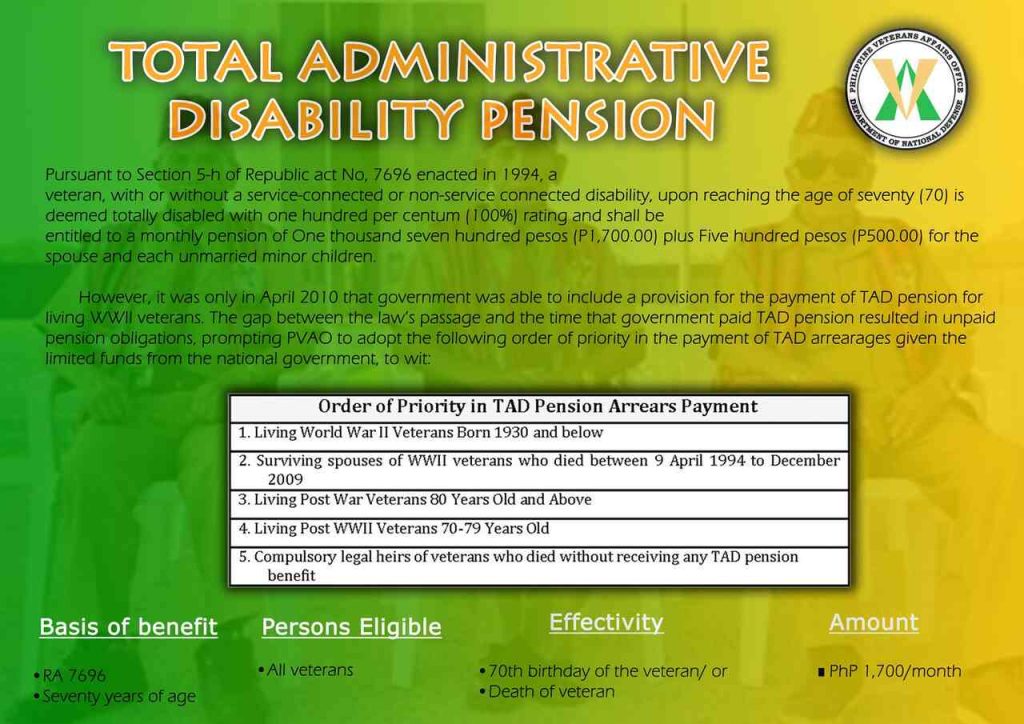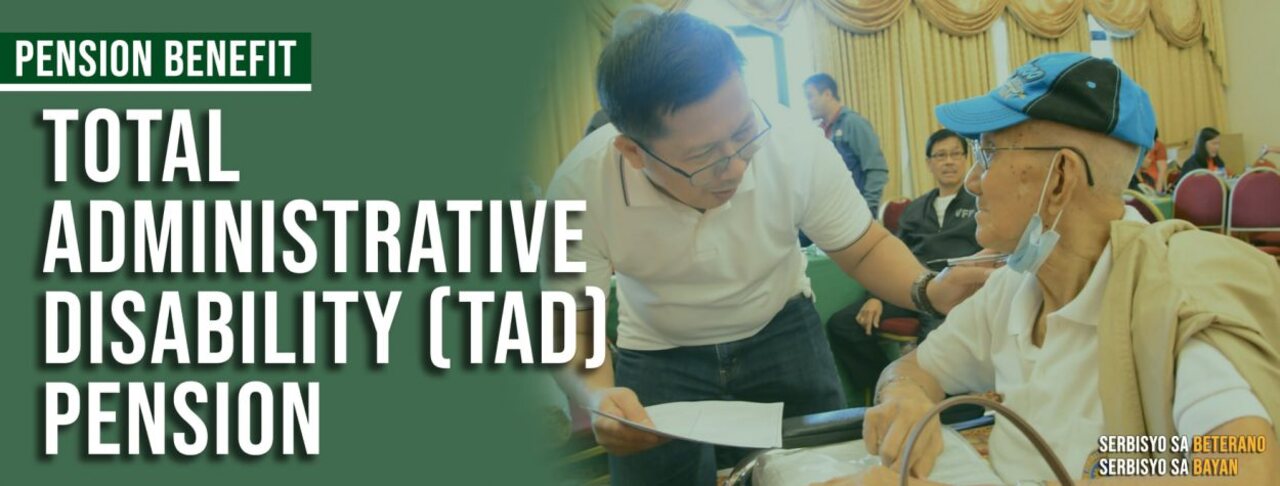The Philippine Veterans Affairs Office (PVAO) Total Administrative Disability (TAD) Pension is a monthly benefit granted to qualified veterans who reach the age of 70, regardless of whether their disability is service-connected. It is a recognition of their service and sacrifices, and aims to provide continued support in their old age. Applying for the program requires the submission of personal, service, and civil documents through the PVAO central or field offices.
This benefit stems from Republic Act No. 6948, amended by Republic Act No. 7696, which institutionalized the pension as an administrative acknowledgment of aging-related disabilities. The application process ensures veterans or their legal dependents receive financial aid that reflects their contribution to national service. Informing the public about the TAD Pension promotes awareness, ensures more veterans access their rightful benefits, and upholds the country’s commitment to honor its heroes. If you or your loved one is a veteran of the Armed Forces of the Philippines (AFP), this comprehensive guide outlines who can apply, what benefits are available, and how to go through the application process.
What Is the PVAO Total Administrative Disability (TAD) Pension?

The TAD pension is a monthly financial benefit granted to Filipino veterans who are deemed totally disabled due to age or service-related injuries or illnesses. Once a veteran reaches the age of 70, they are considered 100% disabled and automatically eligible for this benefit, regardless of whether the disability is service-connected.
PVAO Disability Pension vs Total Administrative Disability (TAD) Pension
The PVAO TAD Pension is distinct from the PVAO Disability Pension in that it is automatically granted to veterans upon reaching 70 years of age, even if their disability is not service-related. In contrast, the Disability Pension is awarded based on service-connected injuries or illnesses incurred during active duty. The TAD Pension functions as a form of social support rather than a compensation for war-related disability. Its primary goal is to provide continued care and financial assistance to elderly veterans in recognition of their age and national service. Unlike other disability pensions from the Philippine government or GOCCs, which often require medical assessments, the TAD Pension is simpler to avail and guaranteed by age.
History
The TAD Pension was established under Republic Act No. 6948 in 1990, aimed at standardizing veterans’ benefits by converting military service pay into pensions. It was later amended by Republic Act No. 7696 in 1994 to extend the TAD Pension to all veterans aged 70, regardless of their disability status. This marked a major shift toward age-based entitlement rather than war-related disability evaluation. Over the years, the program has expanded its coverage and simplified its application processes to reach more qualified veterans and their families. Today, the program remains a vital component of the government’s commitment to veteran welfare.
Features and Benefits
Here are the most notable features and benefits of the TAD Pension program:
- Monthly pension of ₱1,700 for qualified veterans aged 70 and above
- Additional ₱500 monthly for the spouse of the veteran
- Additional ₱500 monthly for each unmarried minor child
- Php 20,000.00/month for Senior War Veterans
- Php 5,000.00/month for Post-War Veterans and their surviving spouses
Note: Veterans rated with 91–100% disability are eligible for these benefits.
- No requirement for service-connected disability
- Continued pension benefits to surviving spouses who have not remarried
Target Beneficiaries
The program aims to assist the following target groups:
- Veterans who have reached the age of 70
- Surviving spouses of eligible veterans
- Unmarried minor children of eligible veterans
Qualifications
To receive the pension, target beneficiaries must satisfy the following eligibility criteria:
- Must be a recognized veteran with an established military service record
- Must be 70 years old or older
- Surviving spouse must not have remarried
- Children must be unmarried and minors
- Must not be receiving a similar pension from another government source
Limitations
Do note that the pension comes with specific restrictions as well.
- The surviving spouse must not be receiving a similar pension from any other government fund or the U.S. government.
- Pension ceases if the spouse remarries.
- If a veteran died between April 9, 1990, and April 9, 1994, before reaching 65, pension begins on April 9, 1994, or on the widow’s 65th birthday, whichever comes first.
- If the veteran died after their 65th birthday but within that same date range, the pension begins on the date of death.
- For deaths after April 9, 1994, the pension starts from the date of the veteran’s death.
Application Requirements
Before starting with the application, you will need to prepare the following:
Basic Documents
- Proof of Service
- WWII AFP Veterans: Military Service Record from NRD, OTAG
- Ex-PC serviceman: MSR from Camp Crame
- Philippine Scout: Enlistment record/report of separation from USVA
- Proof of Birth
- Birth certificate from LCR/PSA/Archives (original or certified copy)
- Proof of Death (if applicable)
- Death certificate with registry number
- Proof of Marriage
- Marriage certificate from LCR/PSA
- Valid ID
- Government-issued IDs (passport, driver’s license, COMELEC, GSIS/SSS, etc.)
- Photos
- Two (2) 2×2 ID pictures of the veteran and spouse
Secondary Documents (If Primary Documents Are Missing or Inadequate)
- Service Proof Alternatives
- Discharge certificate
- Form 23/21/24
- Affidavit of two comrades-in-arms
- Birth Proof Alternatives
- Certificate of non-availability
- Baptismal certificate
- Joint affidavit of two disinterested persons
- Death Proof Alternatives
- Certificate of non-availability
- Joint affidavit of two disinterested persons
- Burial permit or interment record
- Casualty report
- Marriage Proof Alternatives (Submit any two)
- Certificate of non-availability
- Joint affidavit of two disinterested persons
- Birth certificate of a child
- Land title
- Declaration of beneficiaries
For Veterans
- Certificate of Disability Discharge (CDD) Worksheet
- Endorsement Letter and Application Form
- Medical examination at AFP Medical Center or nearest government hospital
For Spouse and Children
- Duly accomplished application form
- Original Marriage Contract and CEMAR from PSA
- Birth certificates of minor children from PSA
- One (1) 2×2 ID picture of the claimant
- Photocopies of two (2) government-issued IDs
After Application: Notice of Approval (NOA)
If Claimed by Applicant
- Two (2) valid government-issued IDs
- Original Acknowledgement Receipt
If Claimed by a Representative
- Special Power of Attorney (SPA)
- ID of representative (must be a direct descendant)
- Original Acknowledgement Receipt
- Photocopy of Claimant’s ID
Bank Account Setup for Pension Release
Once the claim is approved:
- Bank Confirmation Slip with 1×1 photo
- ATM or Passbook Snapshot or copy
- Two government-issued IDs (photocopy)
- Special Power of Attorney (if represented)
Notice to Open a PVAO Pension Account (NOPPA)
- Approval Sheet (original copy)
- Bank Enrollment Form (original copy)
Procedures
Once the documents are ready, you can proceed with the application process. To apply, simply follow these steps:
Step 1: Prepare Required Documents
Applicants must gather the required documents. The applicants may also download the application forms from the PVAO website (pvao.gov.ph).
Step 2: Submit the Application
Applications can be submitted to the Documents are submitted to the Armed Forces of the Philippines Pension and Gratuity Management Center (AFPPGMC) for validation, then forwarded to PVAO Central Office at Camp General Emilio Aguinaldo, Quezon City, or through PVAO Field Service Offices.
Step 3: Await Processing
Upon submission, the application will undergo evaluation. The processing time may vary, and applicants will be notified of the outcome.
Where to Submit
The application can be processed via the following offices. You may also secure the application forms here.
- PVAO Central Office: Camp General Emilio Aguinaldo, Quezon City
- PVAO Field Service Offices: Nationwide locations
- PVAO Website for downloadable forms: www.pvao.gov.ph/downloadable-forms
Costs and Processing Time
There are no application fees or charges required to apply for this pension. Applicants simply need to prepare and submit complete documentary requirements, including valid identification and civil registry documents. Processing time may vary but it generally takes about 11 days or so, depending on the completeness of the documents and verification from PVAO; and the applicants are notified once the evaluation is complete.
Reminders
For your reference, here are some things you might want to take note of:
- All claims must be supported with the appropriate documents.
- Discrepancies or missing primary documents must be supported by affidavits and alternative proofs.
- All transactions involving representatives must include a notarized SPA.
- Veterans and their families are encouraged to submit accurate and truthful documents to avoid delays.
- You can receive the PVAO Total Administrative Disability (TAD) Pension even while receiving another PVAO pension — such as the Regular Disability Pension — as long as they are not of the same type and you meet the eligibility requirements for both.
Video: PVAO @78 – Achievement Highlights
Applying for the PVAO Total Administrative Disability (TAD) Pension can help veterans and their families access consistent financial assistance. By knowing the requirements and following the outlined steps, eligible applicants can receive the benefits due to them in recognition of their service. For more information on what the PVAO does along with its achievements in the past 78 years, visit the PVAO Central Office, Field Offices, or official website, or watch this video below:
Contact Information
For further assistance or inquiries, you can reach out to the:
Philippine Veterans Affairs Office (PVAO)
- Office Address: Camp General Emilio Aguinaldo Compound, Col. Boni Serrano Avenue, Quezon City
- Telephone: (+63-02) 8912-4526, Claims – 09308361097, Finance – 09176688072, Records/updating- 09192123074
- Email Address: pvao.publicaffairs@pvao.gov.ph
- Website: https://pvao.gov.ph/
- Facebook: https://www.facebook.com/PVAO1/
- Youtube: https://www.youtube.com/@ThePVAO
